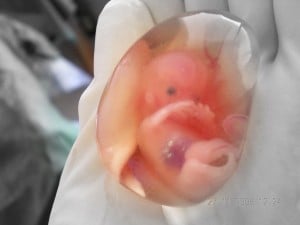From the website of the White House, this quote from First Lady Michelle Obama:
“This is really what the White House is all about. It’s the “People’s House.” It’s a place that is steeped in history, but it’s also a place where everyone should feel welcome. And that’s why my husband and I have made it our mission to open up the house to as many people as we can.”
– Michelle Obama
SO WHY, I ask you, did the White House look like this last night?
The Obama Administration has lit the White House with pink lights for Breast Cancer Awareness Month.
The problem is that many people—myself among them—do not “celebrate” Breast Cancer Awareness Month.
It’s not that critics believe that breast cancer is a good thing; rather, the controversy swirls over whether the funds raised by organizations (such as Komen for the Cure) actually help to find a cure, or whether the “pink ribbon campaign” actually does harm to women by focusing on organizations (such as Planned Parenthood) which provide contraceptives and abortion. Komen has been criticized for its use of donor funds (for a controversial Planned Parenthood grant, for example); for its sponsor affiliations; for its role in commercial cause marketing; and for its use of misleading statistics in advertising.
Susan Perry, author of several books and many articles on health-related issues, explained the sponsorship controversy in MinnPost, a non-profit news site popular with readers in Minneapolis, Minnesota. She explained how the link between breast cancer and environmental toxins was obscured or even denied because of corporate sponsorships:
Last fall, for example, Amy Silverstein reported in Mother Jones about Komen’s tendency to downplay or even deny science that suggests a link between breast cancer and bisphenol A (BPA), a chemical used in plastics and other products.
In fact, as Silverstein pointed out, Komen has a history of downplaying all findings linking environmental toxins to breast cancer.
Could Komen’s stance on this issue, Silverstein asked, be because the organization receives funding from such companies as Coca-Cola, General Mills, 3M and Georgia Pacific (a subsidiary of the Koch Industries), which use those chemicals in their products?
Perry went on to criticize “pinkwashing”, the term used to describe when corporations claim to care about breast cancer by promoting “pink” products or a “pink ribbon” campaign, while continuing to sell products that are linked to the disease.
Then there’s the phenomenon of pinkwashing, which Komen unabashedly created and encourages. Pinkwashing is the term used to describe when corporations claim to care about breast cancer by promoting “pink” products or a “pink ribbon” campaign (especially each October during “Breast Cancer Awareness Month”) while continuing to sell products that are linked to the disease. (One notorious example from a few Octobers ago was a company that promoted “Pinky” vodka to women. Alcohol consumption is generally considered a risk factor for breast cancer.)
But the problem may go deeper than merely shielding corporate sponsors from criticism. Dr. Joel Brind has studied the causative link between abortion and breast cancer. Abortion advocates were once critical of his research claims; however, recent studies have confirmed the causative effects of abortion on development of breast cancer later in life.
In April 2009, the American Association for Cancer Research’s (AACR) medical journal, Cancer Epidemiology, Biomarkers and Prevention, published a study titled “Risk factors for triple-negative breast cancer in women under the age of 45 years”. The study, by well-regarded researchers including Jessica Dolle of the Fred Hutchinson Cancer Research Institute, contained a table reporting a statistically significant 40 percent risk increase for women who have had abortions. The 2009 study was remarkable in that one of the research partners, Dr. Louise Brinton of the U.S. National Cancer Institute (NCI), had reversed her position, after claiming in 2003 that the non-existence of an abortion-breast cancer link was “well established.”
The same study also found a significant link between the use of oral contraceptives and the particularly aggressive cancer known as triple-negative breast cancer (TNBC). In the study, women who began use of oral contraceptives before the age of 18 multiply their risk of TNBC by 3.7 times; and those who had used oral contraceptives within one to five years before the study showed a risk 4.2 times the average. Dr. Joel Brind suggested that oral contraceptives may function not merely as a secondary carcinogen but may be a primary cause of the cell mutations that lead to cancer formation.
 In February 2012, a Canadian documentary Pink Ribbons, Inc. was released. Pink Ribbons explored the apparent corporate capture of breast cancer activism. Lea Pool, the film’s director, contended that Komen’s breast cancer pledge runs have deflected feminist activism away from more controversial issues, and that the money raised by the runs and by “pink ribbon” sales has done little for “the Cure.” In fact, breast cancer rates have increased from one in 22 women in 1940, to one in eight today. Despite the sobering statistics, very little research has been done to determine what environmental or dietary factors may have led to increased cancer rates. The money raised seems to go toward treatment more than toward prevention or discovering a cause and a cure.
In February 2012, a Canadian documentary Pink Ribbons, Inc. was released. Pink Ribbons explored the apparent corporate capture of breast cancer activism. Lea Pool, the film’s director, contended that Komen’s breast cancer pledge runs have deflected feminist activism away from more controversial issues, and that the money raised by the runs and by “pink ribbon” sales has done little for “the Cure.” In fact, breast cancer rates have increased from one in 22 women in 1940, to one in eight today. Despite the sobering statistics, very little research has been done to determine what environmental or dietary factors may have led to increased cancer rates. The money raised seems to go toward treatment more than toward prevention or discovering a cause and a cure.
All of this explains why, when I find a perennial at my local nursery planted in a pink pot, or when a particular lipstick or perfume is associated with the campaign, I deliberately make another selection. One needn’t be an active pro-lifer to recognize the problems with the Breast Cancer Awareness campaign.
And since there are many Americans who do not regard Breast Cancer Awareness Month as worthy of our support, why must our nation’s symbol, “The People’s House” flaunt the gaudy pink color?












